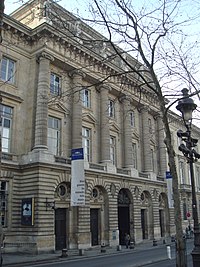The Monnaie de Paris (French pronunciation: [mɔnɛ də paʁi], Paris Mint) is a government-owned institution responsible for producing France's coins. Founded in AD 864 with the Edict of Pistres,[1] it is the oldest continuously running minting institution and one of the oldest extant companies in the world.
 Monnaie de Paris, 11 quai Conti, 75006 Paris | |
| Company type | EPIC |
|---|---|
| Industry | Coin and medal production |
| Founded | 25 June 864 |
| Headquarters | , France |
Area served | France European Union |
Key people | Marc Schwartz (Chief Executive) |
| Products | Coins Medals |
| Owner | French state |
Number of employees | 500 |
| Website | www |

In 1973, the mint relocated its primary production to a facility in Pessac, and today the original facility in Paris, while still operational, functions primarily as a museum and is home to a collection of many ancient coins.
Monnaie de Paris acquired its autonomy and was granted legal personality by law no. 2006–1666 in 2007.[2]
In 2012, it was the first public institution to obtain the Living Heritage Company label.
At the end of September 2017, Monnaie de Paris reopened after renovation work.
Building in Paris
editA Neoclassical edifice, the Hôtel de la Monnaie was designed by Jacques-Denis Antoine and built from 1767–1775 on the Left Bank of the Seine. The Monnaie was the first major civic monument undertaken by Antoine, yet shows a high level of ingenuity on the part of the architect. Today it is considered a key example of French Neoclassicism in pre-Revolutionary Paris. The building is typified by its heavy external rustication and severe decorative treatment. It boasts one of the longest façades on the Seine; its appearance has been likened to the Italian palazzo tradition.[3] The building, which housed mint workshops, administrative rooms, and residential quarters, wraps around a large interior courtyard. It remains open to the public and includes a numismatics museum, located within what was once the main foundry.
Development
editThe Monnaie de Paris employs 500 people (in 2010) on two sites: the Hôtel de la Monnaie in Paris (55% of the workforce) and the monetary establishment in Pessac, in Gironde (45%).[4] In 2019, turnover amounted to 134 million euros for a workforce of 489 employees.[5]
Following a 5-year renovation project known as Metalmetamorphose,[6] the museum at the Monnaie de Paris – known as the Musée du Conti (11 Conti Museum) – was reopened on 30 September 2017.[7]
See also
edit- List of museums in Paris
- Napoleonic medal
- Philippe Danfrie – Superintendent of the Mint in the late 16th century.
- Pierre Marie François Ogé Bust of Jacques Denis Antoine
- List of oldest companies
References
editNotes
- ^ "1,150 years of history". Monnaie de Paris. Archived from the original on 9 February 2022. Retrieved 26 October 2020.
- ^ "Loi du 21 décembre 2006, art. 36". Archived from the original on 2022-04-18. Retrieved 2022-06-01.
- ^ "Monnaie de Paris an unusual site to Visit in Paris". Archived from the original on 2016-03-04. Retrieved 2015-04-13.
- ^ ""Nous avons lancé une pièce en or en 2008. Ce fut un raz-de-marée"". Le Monde.fr (in French). 2010-02-08. Retrieved 2022-06-01.
- ^ "Rapports annuels". www.monnaiedeparis.fr. Archived from the original on 2022-08-07. Retrieved 2022-06-01.
- ^ Video about Metalmetamorphose https://artsandculture.google.com/asset/m%C3%A9talmorphoses-christophe-beaux/7QHj9ffwgEM9ZQ Archived 2022-08-07 at the Wayback Machine
- ^ "Home | Monnaie de Paris". www.monnaiedeparis.fr. Archived from the original on 8 April 2017. Retrieved 27 September 2017.[title missing]
Sources
External links
edit48°51′24″N 2°20′21″E / 48.85667°N 2.33917°E